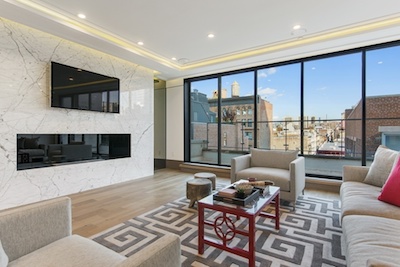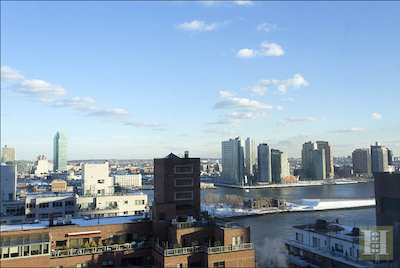 131 East 92nd St townhouse; via StreetEasy
131 East 92nd St townhouse; via StreetEasy
In New York, price growth is slowing and homes are staying on the market for longer, according to a new report from StreetEasy. The price growth in both New York’s Manhattan and Brooklyn boroughs has been slowing since December 2012 and July 2015, respectively, with days on market also reaching recent highs. With the dollar strong against other currencies, foreigners are less likely to purchase property as an investment, thus hurting demand. "For the overall market, slower price growth and longer time on market isn’t necessarily a sign that prices will drop," said Alan Lightfeldt, data scientist at StreetEasy. "It is, however, a sign that we’re returning to a more stable pace of growth, similar to what the market reported in 2013.
"In terms of the luxury tier, we’re already seeing prices decline in Manhattan," he said. As developers rushed to meet burgeoning global demand, luxury homes represented the vast majority of new product entering the market between 2014 and now.
"With demand beginning to wane, we’ve seen a considerable increase in the length of time that luxury units spend on the market – a reflection of oversupply at this end of the market - and prices among top-tier homes in Manhattan have actually declined each consecutive month since May 2015."
Tumbling down Although prices are increasing at comparably low rates, growth is still considerable. In the Manhattan borough, year-over-year price in January was up 5.3 percent, while Brooklyn saw an 8.5 percent rise. However, slowing condominium sales have extended the median time on market considerably. Luxury homes that went into contract in January spent a median 131 days on the market, 33 days more than last year. In Brooklyn the increase was 18 days, or a median of 85. Looking solely at condominiums, the median Brooklyn unit spent a remarkable 45 more days, or 103 overall. StreetEasy notes that an increase of this size indicates hesitant or worrisome buyers and is not merely a seasonal issue. TriBeCa condominium; via StreetEasy
The median price of New York luxury real estate has also dropped. It peaked in May at $3.27 million but fell 0.3 percent to $3.26 million by the end of the year. Nevertheless, StreetEasy projects an increase of 4.1 percent in overall home prices by next year.
This increase will continue the slowdown and marks an end to 2013-2014’s period of rapid growth. The city will more likely settle into a stable market characterized by steady growth rather than rapid upticks.
Also of note, the inexpensive East Brooklyn submarket has spurred much of the borough’s overall growth, growing over 25 percent compared to last year by median resale price. More affluent sections of the borough have been considerably more impacted by the city’s overall slowdown and buyer fatigue, growing at half the rate of the borough as a whole.
TriBeCa condominium; via StreetEasy
The median price of New York luxury real estate has also dropped. It peaked in May at $3.27 million but fell 0.3 percent to $3.26 million by the end of the year. Nevertheless, StreetEasy projects an increase of 4.1 percent in overall home prices by next year.
This increase will continue the slowdown and marks an end to 2013-2014’s period of rapid growth. The city will more likely settle into a stable market characterized by steady growth rather than rapid upticks.
Also of note, the inexpensive East Brooklyn submarket has spurred much of the borough’s overall growth, growing over 25 percent compared to last year by median resale price. More affluent sections of the borough have been considerably more impacted by the city’s overall slowdown and buyer fatigue, growing at half the rate of the borough as a whole.
 View from 415 East 54th St, #22M; via StreetEasy
The same is largely true in Manhattan, where luxury homes grow much more modestly or fall by some measures while other homes see sizable appreciation that skews the numbers.
Even over a longer period of time, from 2010 to 2015, median resale price of luxury homes fell behind the resale price of all homes. The luxury tier grew the fastest in Brooklyn over the same time period, but recent months suggest that trend may have reached its end.
View from 415 East 54th St, #22M; via StreetEasy
The same is largely true in Manhattan, where luxury homes grow much more modestly or fall by some measures while other homes see sizable appreciation that skews the numbers.
Even over a longer period of time, from 2010 to 2015, median resale price of luxury homes fell behind the resale price of all homes. The luxury tier grew the fastest in Brooklyn over the same time period, but recent months suggest that trend may have reached its end.
 212 Warren Street #14L via StreetEasy
"Sales and rent price growth are stabilizing across Manhattan and Brooklyn," said StreetEasy data scientist Alan Lightfeldt in a statement. "Sellers in this market may discover that they cannot set prices and expectations high with the anticipation of a quick sale. The market is starting to look more like 2013, a period of stable growth prior to the surge of 2014 and 2015."
Managing volatility
While New York’s growth will likely stabilize in the coming year, the U.S. is experiencing gains in the luxury real estate sector elsewhere, at least in the short-term.
In an apparent reversal of the ongoing trend, luxury real estate prices in the United States increased in the fourth quarter of 2015 by 3.1 percent from the year-ago period, according to real estate brokerage Redfin.
The first three quarters of 2015 all saw the market slumping, but big gains in Philadelphia, Austin, TX and Sacramento, CA buoyed the market. Despite the good news, stock market volatility is leading big markets to decline and oil prices are shaking up some traditionally strong markets, so the increase may be an anomalous highpoint within a continuing downward trend (see story).
When both the Shanghai Stock Exchange and the Dow Jones experienced big drops in the latter half of 2015, affluent consumers from America, China and elsewhere sought the sturdy New York real estate market as an investment alternative.
China, along with Canada and the United Kingdom, is among the premier foreign investors in United States real estate, making up 16 percent of purchases of single-family homes and condominiums from abroad. In addition, the average purchase price of a property being bought by Chinese consumers is nearly two-and-a-half times the national average, at a bit more than $830,000.
Moreover, even as there are fewer investments in real estate from abroad, the value of the homes being purchased continues to increase, according to the National Association of Realtors’ Economists’ Outlook blog. This indicates that those who continue to invest in U.S. real estate from abroad are luxury consumers making larger investments (see story).
212 Warren Street #14L via StreetEasy
"Sales and rent price growth are stabilizing across Manhattan and Brooklyn," said StreetEasy data scientist Alan Lightfeldt in a statement. "Sellers in this market may discover that they cannot set prices and expectations high with the anticipation of a quick sale. The market is starting to look more like 2013, a period of stable growth prior to the surge of 2014 and 2015."
Managing volatility
While New York’s growth will likely stabilize in the coming year, the U.S. is experiencing gains in the luxury real estate sector elsewhere, at least in the short-term.
In an apparent reversal of the ongoing trend, luxury real estate prices in the United States increased in the fourth quarter of 2015 by 3.1 percent from the year-ago period, according to real estate brokerage Redfin.
The first three quarters of 2015 all saw the market slumping, but big gains in Philadelphia, Austin, TX and Sacramento, CA buoyed the market. Despite the good news, stock market volatility is leading big markets to decline and oil prices are shaking up some traditionally strong markets, so the increase may be an anomalous highpoint within a continuing downward trend (see story).
When both the Shanghai Stock Exchange and the Dow Jones experienced big drops in the latter half of 2015, affluent consumers from America, China and elsewhere sought the sturdy New York real estate market as an investment alternative.
China, along with Canada and the United Kingdom, is among the premier foreign investors in United States real estate, making up 16 percent of purchases of single-family homes and condominiums from abroad. In addition, the average purchase price of a property being bought by Chinese consumers is nearly two-and-a-half times the national average, at a bit more than $830,000.
Moreover, even as there are fewer investments in real estate from abroad, the value of the homes being purchased continues to increase, according to the National Association of Realtors’ Economists’ Outlook blog. This indicates that those who continue to invest in U.S. real estate from abroad are luxury consumers making larger investments (see story).
However, market volatility may still appeal to some foreign investors regardless of the value of the dollar, and the behavior of local buyers is of course a significant factor.
"The strength of the U.S. dollar certainly makes it so that NYC housing feels more expensive this season relative to last year," Mr. Lightfeldt said. "While it is possible foreign investors may pull back on investments in the luxury end, the volatility of foreign markets can also make U.S assets more appealing as foreign investors pursue a flight to safety, i.e moving their cash to assets that are expected to yield a relatively safer consistent return than what may be available in their local markets.
"We also cannot attribute the entirety of the slowdown in the luxury end with the wax and wane of foreign investment," he said. "As the supply and demand for luxury homes readjusts, we expect that prices will continue to decline in 2016. Sellers will certainly need to adjust their expectations and asking prices this year."
